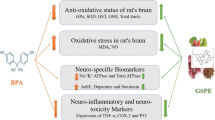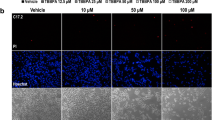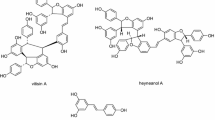Abstract
Lignin exhibits antioxidative and various other biological properties. However, its neuroprotection capability has rarely been studied. In this study, three types of lignin with different structures were prepared from grape seeds by using different isolation techniques. The antioxidative and neuroprotective effects of the lignin fractions were evaluated with the apoptosis model of murine neuroectodermal (NE-4C) neural stem cells stimulated with bisphenol AF. The results demonstrated that the half maximal inhibitory concentration for scavenging 2,2-diphenyl-1-picrylhydrazyl with water-soluble lignin (L-W, 58.19 µg·mL−1) was lower than those of lignin in the autohydrolyzed residue of grape seeds (84.27 µg·mL−1) and original lignin in grape seeds (99.44 µg·mL−1). BPAF exposure had negative effects on the reactive oxygen species, malondialdehyde content, and superoxide dismutase and glutathione peroxidase activities in NE-4C cells, which can be reversed by using the prepared lignin to reduce oxidative stress. An immunofluorescence assay demonstrated that grape seed lignin induced protective effects on BPAF-injured NE-4C cells via the nuclear factor erythroid 2-related Factor 2 pathway. In addition, correlational analyses showed that lignin (L-W) with lower molecular weights and noncondensed phenolic hydroxyl group content and higher contents of COOH groups effectively prevented cell apoptosis, scavenged reactive oxygen species, and ensured protection from nerve injury. This study demonstrated that grape seed lignin can be used as a neuroprotective agent and serves as a demonstration of active lignin production from grape seed waste.

Similar content being viewed by others
References
Hu T Q. Chemical Modification, Properties, and Usage of Lignin. New York: Kluwer academic/Plenum publishers, 2002: 81–82
Liu H Y, Xu T, Liu K, Zhang M, Liu W, Hao L, Du H S, Si C L. Lignin-based electrodes for energy storage application. Industrial Crops and Products, 2021, 165: 113425
Chen Z S, Yan M, Pei W, Yan B, Huang C, Chan H Y E. Lignin-carbohydrate complexes suppress SCA3 neurodegeneration via upregulating proteasomal activities. International Journal of Biological Macromolecules, 2022, 218: 690–705
Liu K, Du H S, Zheng T, Liu W, Zhang M, Liu H Y, Zhang X Y, Si C L. Lignin-containing cellulose nanomaterials: preparation and applications. Green Chemistry, 2021, 23: 9723–9746
Pei W, Deng J, Wang P, Wang X, Zheng L, Zhang Y, Huang C. Sustainable lignin and lignin-derived compounds as potential therapeutic agents for degenerative orthopaedic diseases: a systemic review. International Journal of Biological Macromolecules, 2022, 212: 574–560
Shao Z, Fu Y, Wang P, Zhang Y, Qin M, Li X, Zhang F. Modification of the aspen lignin structure during integrated fractionation process of autohydrolysis and formic acid delignification. International Journal of Biological Macromolecules, 2020, 165: 1727–1737
Pu Y, Hu F, Huang F, Ragauskas A J. Lignin structural alterations in thermochemical pretreatments with limited delignification. BioEnergy Research, 2015, 8: 992–1003
Lagerquist L, Pranovich A, Sumerskii I, Schoultz S V, Vähäsalo L, Willför S, Eklund P. Structural and thermal analysis of softwood lignins from a pressurized hot water extraction biorefinery process and modified derivatives. Molecules, 2019, 24: 335
Lagerquist L, Pranovich A, Smeds A, Schoultz S, Vähäsalo L, Rahkila J, Kilpeläinen I, Tamminen T, Willför S, Eklund P. Structural characterization of birch lignin isolated from a pressurized hot water extraction and mild alkali pulped biorefinery process. Industrial Crops and Products, 2018, 111: 306–316
Yao L, Xiong L, Yoo C G, Dong C, Meng X, Dai J, Ragauskas A J, Yang C, Yu J, Yang H, Xiong C. Correlations of the physicochemical properties of organosolv lignins from Broussonetia papyrifera with their antioxidant activities. Sustainable Energy & Fuels, 2020, 4: 5114–5119
Dizhbite T, Telysheva G, Jurkjane V, Viesturs U. Characterization of the radical scavenging activity of lignins-natural antioxidants. Bioresource Technology, 2004, 95: 309–317
Liu H Y, Xu T, Cai C Y, Liu K, Liu W, Zhang M, Du H S, Si C L, Zhang K. Multifunctional superelastic, superhydrophilic, and ultralight nanocellulose-based composite carbon aerogels for compressive supercapacitor and strain sensor. Advanced Functional Materials, 2022, 32: 2113082
Liu W, Liu K, Du H S. Zheng, Zhang N, Xu T, Pang B, Zhang X Y, Si C L, Zhang K. Cellulose nanopaper: fabrication, functionalization, and applications. Nano-Micro Letters, 2022, 14: 104
Wang R, Zheng L, Xu Q, Xu L, Wang D, Li J, Lu G, Huang C, Wang Y. Unveiling the structural properties of water-soluble lignin from gramineous biomass by autohydrolysis and its functionality as a bioactivator (anti-inflammatory and antioxidative). International Journal of Biological Macromolecules, 2021, 191: 1087–1095
Park S Y, Park S J, Park N J, Joo W H, Lee S J, Choi Y W. α-Isocubebene exerts neuroprotective effects in amyloid beta stimulated microglia activation. Neuroscience Letters, 2013, 555: 143–148
Song F, Zeng K, Liao L, Yu Q, Tu P, Wang X. Schizandrin a inhibits microglia-mediated neuroninflammation through inhibiting TRAF6-NF-κB and Jak2-Stat3 signaling pathways. PLoS One, 2016, 11: e0149991
Zhou F, Wang M, Ju J, Wang Y, Liu Z, Zhao X, Yan Y, Yan S, Luo X, Fang Y. Schizandrin A protects against cerebral ischemia-reperfusion injury by suppressing inflammation and oxidative stress and regulating the AMPK/Nrf2 pathway regulation. American Journal of Translational Research, 2019, 11: 199–209
Gu J, Zhang J, Chen Y, Wang H, Guo M, Wang L, Wang Z, Wu S, Shi L, Gu A, et al. Neurobehavioral effects of bisphenol S exposure in early life stages of zebrafish larvae (Danio rerio). Chemosphere, 2019, 217: 629–635
OIV. 2019 Statistical Report on World Vitiviniculture. International Organisation of Vine and Wine. Available online: 2019
Yedro F M, Serna J G, Cantero D A, Sobrón F, Cocero M J. Hydrothermal fractionation of grape seeds in subcritical water to produce oil extract, sugars and lignin. Catalysis Today, 2015, 257: 160–168
Prozil S O, Evtuguin D V, Silva A M S, Lopes L P C. Structural characterization of lignin from grape stalks (Vitis vinifera L.). Journal of Agricultural and Food Chemistry, 2014, 62: 5420–5428
Spanghero M, Salem A Z M, Robinson P H. Chemical composition, including secondary metabolites, and rumen fermentability of seeds and pulp of Californian (USA) and Italian grape pomaces. Animal Feed Science and Technology, 2009, 152: 243–255
Vostrejs P, Adamcová D, Vaverková M D, Enev V, Kalina M, Machovsky M, Šourková M, Marova I, Kovalcik A. Active biodegradable packaging films modified with grape seeds lignin. RSC Advances, 2020, 10: 29202–29213
Huang C, Wang X, Liang C, Jiang X, Yang G, Xu J, Yong Q. A sustainable process for procuring biologically active fractions of high-purity xylooligosaccharides and water-soluble lignin from Moso bamboo prehydrolyzate. Biotechnology for Biofuels, 2019, 12: 189
Bjorkman A. Studies on finely divided wood. Part I. Extraction of lignin with neutral solvents. Svensk Papperstidning, 1956, 59: 477–485
Bjorkman A. Lignin and lignin-carbohydrate complexes. Industrial & Engineering Chemistry, 1957, 49: 1395–1398
Sluiter J, Sluiter A. Summative mass closure—LAP review and integration: pretreated slurries. NREL/TP-510-48825, 2010
Huang C, He J, Narron R, Wang Y, Yong Q. Characterization of kraft lignin fractions obtained by sequential ultrafiltration and their potential application as a biobased component in blends with polyethylene. ACS Sustainable Chemistry & Engineering, 2017, 5: 11770–11779
Betts W B, Dart R K, Ball A S, Pedlar S. Biosynthesis and Structure of Lignocellulose. In: Betts W B, ed. Biodegradation: Natural and Synthetic Materials. Berlin: Springer-Verlag, 1991, 139–155
Dong H, Zheng L, Yu P, Jiang Q, Wu Y, Huang C, Yin B. Characterization and application of lignin-carbohydrate complexes from lignocellulosic materials as antioxidants for scavenging in vitro and in vivo reactive oxygen species. ACS Sustainable Chemistry & Engineering, 2019, 8: 256–266
Huang C, He J, Du L, Min D, Yong Q. Structural characterization of the lignins from the green and yellow bamboo of bamboo culm (Phyllostachys pubescens). Journal of Wood Chemistry and Technology, 2015, 85: 157–172
Río J C D, Prinsen P, Cadena E M, Martínez Á T, Gutiérrez A, Rencoret J. Lignin-carbohydrate complexes from sisal (Agave sisalana) and abaca (Musa textilis): chemical composition and structural modifications during the isolation process. Planta, 2016, 243: 1143–1158
Chen X, Li H, Sun S, Cao X, Sun R. Co-production of oligosaccharides and fermentable sugar from wheat straw by hydrothermal pretreatment combined with alkaline ethanol extraction. Industrial Crops and Products, 2018, 111: 78–85
Zheng L, Lu G, Pei W, Yan W, Li Y, Zhang L, Huang C, Jiang Q. Understanding the relationship between the structural properties of lignin and their biological activities. International Journal of Biological Macromolecules, 2021, 190: 291–300
Gu J, Guo M, Zheng L, Yin X, Zhou L, Fan D, Shi L, Huang C, Ji G. Protective effects of lignin-carbohydrate complexes from wheat stalk against bisphenol a neurotoxicity in zebrafish via oxidative stress. Antioxidants, 2021, 10: 1640
Sevastyanova O, Helander M, Chowdhury S, Lange H, Wedin H, Zhang L, Ek M, Kadla J F, Crestini C, Lindström M E. Tailoring the molecular and thermos-mechanical properties of kraft lignin by ultrafiltration. Journal of Applied Polymer Science, 2014, 131: 40799
Zhang Y, Wang S, Xu W, Cheng F, Pranovich A, Smeds A, Willför S, Xu C. Valorization of lignin-carbohydrate complexes from hydrolysates of Norway spruce: efficient separation, structural characterization, and antioxidant activity. ACS Sustainable Chemistry & Engineering, 2018, 10: 1447–1456
Huang C F, Liu S H, Su C C, Fang K M, Yen C C, Yang C Y, Tang F C, Liu J M, Wu C C, Lee K I, Chen Y W. Roles of ERK/Akt signals in mitochondria-dependent and endoplasmic reticulum stress-triggered neuronal cell apoptosis induced by 4-methyl-2,4-bis(4-hydroxyphenyl)pent-1-ene, a major active metabolite of bisphenol A. Toxicology, 2021, 455: 152764
Gu J, Guo M, Yin X, Huang C, Qian L, Zhou L, Wang Z, Wang L, Shi L, Ji G. A systematic comparison of neurotoxicity of bisphenol A and its derivatives in zebrafish. Science of the Total Environment, 2022, 805: 150210
Yun J, Wei L, Li W, Gong D, Qin H, Feng X, Li G, Ling Z, Wang P, Yin B. Isolation the high antimicrobial ability lignin from bamboo kraft lignin by organosolv fractionation. Frontiers in Bioengineering and Biotechnology, 2021, 9: 363
Santos D K D D N, Barros B R D S, Aguiar L M D S, Filho I J D C, Lorena V M B D, Melo C M L D, Napoleão T H. Immunostimulatory and antioxidant activities of a lignin isolated from Conocarpus erectus leaves. International Journal of Biological Macromolecules, 2020, 150: 169–177
Ma Z, Tang J, Li S, Suo E. Reactivity improvement of cellulolytic enzyme lignin via mild hydrothermal modification. Bioorganic Chemistry, 2017, 75: 173–180
Wu M, Xu L, Teng C, Xiao X, Hu W, Chen J, Tu W. Involvement of oxidative stress in di-2-ethylhexylphthalate (DEHP)-induced apoptosis of mouse NE-4C neural stem cells. Neurotoxicology, 2019, 70: 41–47
Rolas L, Boussif A, Weiss E, Lettéron P, Haddad O, El-Benna J, Rautou P E, Moreau R, Périanin A. NADPH oxidase depletion in neutrophils from patients with cirrhosis and restoration via tolllike receptor 7/8 activation. Gut, 2018, 67: 1505–1516
Pan J, Hao X, Yao H, Ge K, Ma L, Ma W. Matrine inhibits mycelia growth of Botryosphaeria dothidea by affecting membrane permeability. Journal of Forestry Research, 2019, 30: 1105–1113
Li C, Han Y, Hao J, Qin X, Liu C, Fan S. Effects of exogenous spermidine on antioxidants and glyoxalase system of lettuce seedlings under high temperature. Plant Signaling & Behavior, 2020, 15: e182469
Rubiolo J A, Mithieux G, Vega F V. Resveratrol protects primary rat hepatocytes against oxidative stress damage: activation of the Nrf2 transcription factor and augmented activities of antioxidant enzymes. European Journal of Pharmacology, 2008, 591: 66–72
Yang Q, Pan X. Correlation between lignin physicochemical properties and inhibition to enzymatic hydrolysis of cellulose. Biotechnology and Bioengineering, 2016, 113: 1213–1224
Zhang Y, Li H, Jin S, Lu Y, Peng Y, Zhao L, Wang X. Cannabidiol protects against Alzheimer’s disease in C. elegans via ROS scavenging activity of its phenolic hydroxyl groups. European Journal of Pharmacology, 2022, 919: 174829
Na Y, Woo J, Choi W I, Sung D. Novel carboxylated ferrocene polymer nanocapsule with high reactive oxygen species sensitivity and on-demand drug release for effective cancer therapy. Colloids and Surfaces B: Biointerfaces, 2021, 200: 1115
Nenadis N, Samara E, Mantzouridou F T. On the role of the carboxyl group to the protective effect of o-dihydroxybenzoic acids to saccharomyces cerevisiae cells upon induced oxidative stress. Antioxidants, 2022, 11(1): 161
Acknowledgments
This work was sponsored by the National Natural Science Foundation of China for Youth (Grant No. 81901873), the Jiangsu Qing Lan Project (for Dr. Caoxing Huang) and the Young Elite Scientists Sponsorship Program by CAST (for Dr. Caoxing Huang).
Author information
Authors and Affiliations
Corresponding authors
Rights and permissions
About this article
Cite this article
Yan, B., Lu, G., Wang, R. et al. Protective effects of lignin fractions obtained from grape seeds against bisphenol AF neurotoxicity via antioxidative effects mediated by the Nrf2 pathway. Front. Chem. Sci. Eng. 17, 976–989 (2023). https://doi.org/10.1007/s11705-022-2237-0
Received:
Accepted:
Published:
Issue Date:
DOI: https://doi.org/10.1007/s11705-022-2237-0




